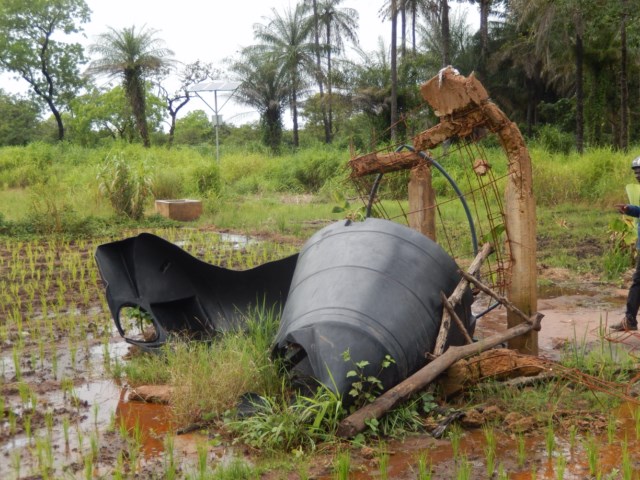Rainwater Tanks in Highlands, Peru
| Topic | Conversation | Images / Documents |
|---|---|---|
| Rainwater Tanks in Highland, Peru |
Good morning to all,
A question about rainwater harvesting in Peru: does anybody have experiences in constructing rainwater harvesting tanks or other rainwater harvesting structures for drinking and domestic water purposes in the Andes or other drylands? We are working in the region of Puno in the south of Peru, near the Bolivian border. The climate is arid with rainfall. There are some plastic tanks build. We would prefer though to work with ferro cement or other materials that have a longer life span and include more community work. Ok, looking forward to any response also from similar climates. All the best, M | |
| Have you tried EMAS BOLIVIA . Large number of very good videos with detailed instructions posted in you tube.
- S | ||
| Dear M,
Thank for your email, for your indeed information. I guess, we can further discuss about this. In November 2014, WEDC conference has been organized and I have seen some possibly opted as roof and rock rainwater catchment. In our organization, RainWater Cambodia, we have been installing a few thousands of domestic and institutional system of rain water harvesting for householders and local institution as school and rural health clinic. In particular, the ferro-cement tank is the most relevant system built for those local institution. For further information, I can be contacted in the person. And our system built is followed the risk management model as description in the attached briefing research paper from our organization. Best regards, K |
Rainwater Harvesting Formalization for Rural Cambodia, 37th WEDC International Conference, Hanoi, Vietnam, 2014 | |
| Dear M,
Have a look at what EMAS does in Bolivia (links to right). Building water-tight ferrocement tanks can be a bit tricky though and definitely needs some skilled training. They are also much more sensitive to cracking from small earthquakes if that is an issue in the region. Best regards, -K |
EMAS | |
| Great information, Thank you very much to both, Krischan and Kea.
@Krischan, do you know why you used ferro-cement tanks in Bolivia and not the usual plastic tanks that are used a lot in Latin America? In the project we will propose I will also go for ferro-cement, but am still looking for good arguments, such as longer life time of tanks, local work force included in construction thus higher chance of local ownership, etc.... Also, is there any chance that you have the budget for the installed tanks/project to have an idea about the material costs? Many thanks! - M | ||
| Hello M, I am not affiliated with EMAS, so you will have to get in contact with them for details and costs (although these are very site specific and you need to factor in training costs). I know though that one of the most important principles of all their technologies is that they can be build with locally available (in the village) standard materials, which plastic tanks clearly aren't. It might also be partially a transport issue, with tanks being quite bulky and thus expensive to transport over longer distances. The ferrocement tanks are also clearly easier to repair on site and they might have a substantial advantage in high altitudes due to UV insolation not being an issue at all (yes most plastic tank producers claim that their tanks are UV resistant, but this just somewhat elongates their lifespan). In my opinion ferrocement tanks are an interesting self-supply technology, but if affordable plastic tanks are available these are often the better option. I think you'll need to evaluate the site specific conditions first. If you are dealing with really remote communities, that are mostly self-sufficient, ferrocement tanks are probably the preferable technology. Good luck with the project proposal! And try to include a Training of Trainers session at the EMAS technology school in Puerto Pérez (a bit west of La Paz) to get good hands of training for the construction of ferrocement tanks. Best regards, -K P.S.: I'll be most likely in Bolivia & Peru in January or February (as a semi-holiday trip, as I am based in Chile starting next month), but I would be happy to have a look at your plans and make some suggestions in an informal manner. Send me a message on my private email. | ||
| Dear M,
On arguments for using ferrocement tanks instead of plastic tanks, please note that I included a copy of the argumentation by local NGOs in favour of local production of ferrocement tanks as against the plan of the central government in Brasilia to provide plastic tanks in the report that I wrote for RAIn after my visit to North Eastern Brazil in April 2013. The document can be downloaded from Rain4food.net (see right). Page 8 has the argument in English (page attached), and annex 5 the original in Portuguese. You can also have a look at the Akvopedia webpage (on right), which has several examples of ferro cement tanks and their requirements. Or download the Sri Lanka manual. - H |
||
| Dear M,
Further to my mail of a while ago, please note that in Nepal, in school environments, I have seen many plastic tanks that were damaged. Maybe some children had been throwing stones at them. Anyway, with elevated locations, stronger UV radiation may cause the tanks to become more brittle over time, in combination with low temperatures... this may further increase the risk of cracks and damage by playing children. Best regards, - H |
Storing a Polyethylene Tank Outside: What to Consider | |
| Dear H,
Perhaps you can help us in Kinshasa. We are looking for somebody in Kinshasawho is interested in RWH. My supporting network in Congo is very small, while the need for RWH is very big. In the suburb Menkao live 35.000 people, mostly poor immigrants from unsafe East Congo. The ground water is 200 m. deep and the next well is at a distance of 20 km. During the period of 28 November until 12 December we give training for a group of local masons in Kinshasa to construct rain water tanks. Also there is an evaluation of the practical use of 30 family tanks, already constructed in Menkao. Since March 2014 we work together wit a local engineer and with the Technical School of Don Bosco. We like to invite guests during the training to bring them in contact with RWH, because we mean to extend RWH in Congo. Do you have a suggestion? Thank you and best regards - P | ||
| Dear H and M,
Thank you very much for the interesting discussion and the "short learning note" about N E Brazil. Perhaps I can attribute with our experience. Since 2005 our organisation De Gevulde Waterkruik constructed 1500 ferro cement tanks of 5000 litre of in Guinea-Bissaufor households. The tanks are locally made and can be repaired. Families are very satisfied. InGuinea-Bissau plastic tanks are 2,5 x so expensive , not so strong and the water from ferrocement tanks tastes much better. On the website you can find the evaluation report of Hans Hartung 2013 in the annex I sent you the MANUAL in English language. In 2014 we started to construct the good and beautiful Calabash Tank. See annex. The Manual will be available in 2015. Kind regards, - P |
 | |
| Dear Paul, You can promote both rainwater harvesting from roofs and runoff harvesting which permits to collect much water. For domestic water supply, you should combine runoff harvesting basins with biosand filters and chlorination in other to help much people. Unfortunately, I work in arid and semi-arid areas, the Sahel Zone in West Africa and I have not much information about climate condition in RDC. Best regards, - S |
|

